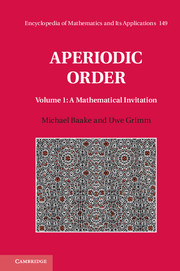Crossref Citations
This Book has been
cited by the following publications. This list is generated based on data provided by Crossref.
Pleasants, Peter A. B.
and
Huck, Christian
2013.
Entropy and Diffraction of the $$k$$ k -Free Points in $$n$$ n -Dimensional Lattices.
Discrete & Computational Geometry,
Vol. 50,
Issue. 1,
p.
39.
Grimm, Uwe
and
Baake, Michael
2013.
Aperiodic Crystals.
p.
11.
Terauds, Venta
2013.
The Inverse Problem of Pure Point Diffraction—Examples and Open Questions.
Journal of Statistical Physics,
Vol. 152,
Issue. 5,
p.
954.
Terauds, Venta
and
Baake, Michael
2013.
Aperiodic Crystals.
p.
35.
Moll, M.
2014.
On a Family of Random Noble Means Substitutions.
Acta Physica Polonica A,
Vol. 126,
Issue. 2,
p.
539.
Grimm, U.
and
Baake, M.
2014.
Recent Progress in Mathematical Diffraction.
Acta Physica Polonica A,
Vol. 126,
Issue. 2,
p.
474.
Strungaru, Nicolae
2014.
On weighted Dirac combs supported inside model sets.
Journal of Physics A: Mathematical and Theoretical,
Vol. 47,
Issue. 33,
p.
335202.
Diehl, R. D.
Li, H. I.
Su, S. Y.
Mayer, A.
Stanisha, N. A.
Ledieu, J.
Lovelock, K. R. J.
Jones, Robert G.
Deyko, A.
Wearing, L. H.
McGrath, R.
Chaudhuri, A.
and
Woodruff, D. P.
2014.
Quantitative Adsorbate Structure Determination for Quasicrystals Using X-Ray Standing Waves.
Physical Review Letters,
Vol. 113,
Issue. 10,
van Enter, A.C.D.
2014.
Aperiodicity in Equilibrium Systems: Between Order and Disorder.
Acta Physica Polonica A,
Vol. 126,
Issue. 2,
p.
621.
Baake, M.
Grimm, U.
and
Nilsson, J.
2014.
Scaling of the Thue-Morse Diffraction Measure.
Acta Physica Polonica A,
Vol. 126,
Issue. 2,
p.
431.
Kellendonk, J.
2014.
Topological Bragg Peaks and How They Characterise Point Sets.
Acta Physica Polonica A,
Vol. 126,
Issue. 2,
p.
497.
Moll, Markus
2014.
Diffraction of Random Noble Means Words.
Journal of Statistical Physics,
Vol. 156,
Issue. 6,
p.
1221.
Jakobi, T.
2014.
Tiling Vertices and the Spacing Distribution of Their Radial Projection.
Acta Physica Polonica A,
Vol. 126,
Issue. 2,
p.
493.
Sandbrink, Matthias
Roth, Johannes
and
Schmiedeberg, Michael
2014.
Comment on “Quantum Quasicrystals of Spin-Orbit-Coupled Dipolar Bosons”.
Physical Review Letters,
Vol. 113,
Issue. 7,
Huck, C.
Moll, M.
and
Nilsson, J.
2014.
Discrete Tomography: Magic Numbers for N-Fold Symmetry.
Acta Physica Polonica A,
Vol. 126,
Issue. 2,
p.
486.
Evidente, Imogene F.
Felix, Rene P.
and
Loquias, Manuel Joseph C.
2015.
Symmetries and color symmetries of a family of tilings with a singular point.
Acta Crystallographica Section A Foundations and Advances,
Vol. 71,
Issue. 6,
p.
583.
Loquias, Manuel Joseph C.
and
Zeiner, Peter
2015.
Coincidence indices of sublattices and coincidences of colorings.
Zeitschrift für Kristallographie - Crystalline Materials,
Vol. 230,
Issue. 12,
p.
749.
BAAKE, MICHAEL
LENZ, DANIEL
and
VAN ENTER, AERNOUT
2015.
Dynamical versus diffraction spectrum for structures with finite local complexity.
Ergodic Theory and Dynamical Systems,
Vol. 35,
Issue. 7,
p.
2017.
Senechal, Marjorie
2015.
Mathematical crystallography in the 21st century.
Zeitschrift für Kristallographie - Crystalline Materials,
Vol. 230,
Issue. 12,
p.
691.
Baake, Michael
Kösters, Holger
and
Moody, Robert V.
2015.
Diffraction Theory of Point Processes: Systems with Clumping and Repulsion.
Journal of Statistical Physics,
Vol. 159,
Issue. 4,
p.
915.





